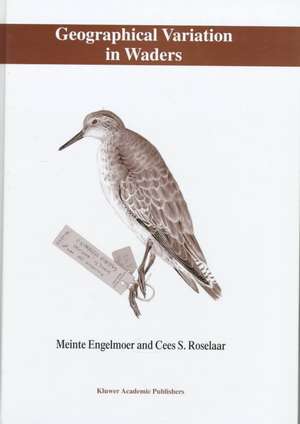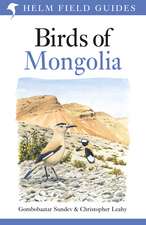Geographical Variation in Waders
Autor M. Engelmoer, C.S. Roselaaren Limba Engleză Hardback – 30 apr 1998
| Toate formatele și edițiile | Preț | Express |
|---|---|---|
| Paperback (1) | 959.04 lei 6-8 săpt. | |
| SPRINGER NETHERLANDS – 16 oct 2012 | 959.04 lei 6-8 săpt. | |
| Hardback (1) | 828.15 lei 38-44 zile | |
| SPRINGER NETHERLANDS – 30 apr 1998 | 828.15 lei 38-44 zile |
Preț: 828.15 lei
Preț vechi: 1089.66 lei
-24% Nou
Puncte Express: 1242
Preț estimativ în valută:
158.46€ • 165.46$ • 130.85£
158.46€ • 165.46$ • 130.85£
Carte tipărită la comandă
Livrare economică 11-17 aprilie
Preluare comenzi: 021 569.72.76
Specificații
ISBN-13: 9780792350200
ISBN-10: 0792350200
Pagini: 331
Ilustrații: XI, 331 p.
Dimensiuni: 210 x 297 x 24 mm
Ediția:1998
Editura: SPRINGER NETHERLANDS
Colecția Springer
Locul publicării:Dordrecht, Netherlands
ISBN-10: 0792350200
Pagini: 331
Ilustrații: XI, 331 p.
Dimensiuni: 210 x 297 x 24 mm
Ediția:1998
Editura: SPRINGER NETHERLANDS
Colecția Springer
Locul publicării:Dordrecht, Netherlands
Public țintă
ResearchCuprins
1 Introduction.- Skin collections.- The phylogeography of waders.- Geographical variation, glaciations, and interstadials.- The inheritance of morphometric characters.- Geographical variation and taxonomy.- Phylogenetics.- 2 Material and methods.- The selected species.- Selecting breeding birds.- The measured variables.- Reliability and reproducibility of measurements.- Statistical analysis of the data.- The distinction of breeding populations.- Construction of a typology.- The difference between ‘types’ and breeding populations.- Predicting geographical breeding origins.- The accuracy of predictions.- The exclusivity of predictions.- Variable selection for future use.- 3 introduction to the species’ accounts.- General information.- The breeding range.- Geographical variation.- Wing structure.- 4 Ringed Plover — Charadrius hiaticula and Semipalmated Plover — Charadrius semipalmatus.- Morphometrical differentiation.- Prediction of breeding origin.- Contact zones.- Body mass.- Primary moult.- Discussion.- Summary.- 5 Eurasian Golden Plover — Pluvialis apricaria.- Morphometrical differentiation.- Prediction of breeding origin.- Body mass.- Primary moult.- Discussion.- Summary.- 6 Grey Plover — Pluvialis squatarola.- Morphometrical differentiation.- Prediction of breeding origin.- Contact zones.- Body mass.- Primary moult.- Discussion.- Summary.- 7 Red Knot — Calidris canutus.- Morphometrical differentiation.- Prediction of breeding origin.- Contact zones.- Body mass.- Primary moult.- Discussion.- Summary.- 8 Sanderling — Calidris alba.- Morphometrical differentiation.- Prediction of breeding origin.- Contact zones.- Body mass.- Primary moult.- Discussion.- Summary.- 9 Curlew Sandpiper — Calidris ferruginea.- Morphometrical differentiation.- Body mass.-Primary moult.- Discussion.- Summary.- 10 Purple Sandpiper — Calidris maritima.- Morphometrical differentiation.- Prediction of breeding origin.- Body mass.- Primary moult.- Discussion.- Summary.- 11 Dunlin — Calidris alpina.- Morphometrical differentiation.- Prediction of breeding origin.- Contact zones.- Body mass.- Primary moult.- Discussion.- Summary.- 12 Black-tailed Godwit — Limosa limosa.- Morphometrical differentiation.- Prediction of breeding origin.- Discussion.- Summary.- 13 Bar-tailed Godwit — Limosa lapponica.- Morphometrical differentiation.- Prediction of breeding origin.- Body mass.- Primary moult.- Discussion.- Summary.- 14 Whimbrel — Numenius phaeopus.- Morphometrical differentiation.- Prediction of breeding origin.- Body mass.- Primary moult.- Discussion.- Summary.- 15 Eurasian Curlew — Numenius arquata.- Morphometrical differentiation.- Prediction of breeding origin.- Contact zones.- Body mass.- Primary moult.- Discussion.- Summary.- 16 Redshank — Tringa totanus.- Morphometrical differentiation.- Prediction of breeding origin.- Contact zones.- Body mass.- Primary moult.- Discussion.- Summary.- 17 Ruddy Turnstone — Arenaria interpres.- Morphometrical differentiation.- Prediction of breeding origin.- Body mass.- Primary moult.- Discussion.- Summary.- 18 General discussion.- Variation among and within species.- Have long-distance migrants short and small wings?.- Morphometrics in relation to sexual size dimorphism.- Skewed sex-ratios on the breeding grounds.- Estimating the composition of wader populations.- Morphometrics and DNA-studies.- Geographical isolation in low arctic Canada.- Curlew species in Kazakhstan and S Russia.- Which measurements ought to be included in morphometric studies?.- 19 References.- Annex 1. Summary ofmorphometric data.- Annex 2. Lengths of primaries in relation to maximum wing lengths.- Annex 3. POSCON and the prediction of a bird’s breeding origin or sex.- I — The POSCON user manual.- II — the samples of breeding populations of waders.
Recenzii
`...This is an important modern study of the geographical variation in birds in general and waders in particular. It is therefore of great interest to systematic ornithologists and to all those field ornithologists involved in the ringing and measuring of waders during migration or on the wintering grounds., especially to those workers analysisng the large data sets gathered every year. Hopefully, this book will encourage eco-ethologists to undertake comparative studies of those conspesific wader populations which the authors have distinguished taxonomically.'
Ethology, 106(1):1-104 (2000)
`This is an impressive book in more ways than one. ... Should you buy this book? If you have any interest in waders then my answer would be an emphatic yes. ... It is an excellent book.'
Ibis, 142 (2000)
Ethology, 106(1):1-104 (2000)
`This is an impressive book in more ways than one. ... Should you buy this book? If you have any interest in waders then my answer would be an emphatic yes. ... It is an excellent book.'
Ibis, 142 (2000)



